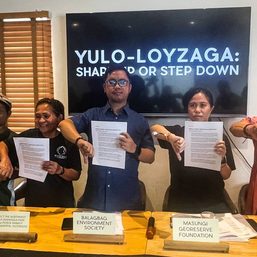SUMMARY
This is AI generated summarization, which may have errors. For context, always refer to the full article.

CEBU, Philippines – Local officials, academicians, and environmentalists urged better enforcement of environmental policies in Cebu with the launch of an “Environmental Enforcement Manual” on Wednesday, February 7.
The manual, an offshoot of a community-based environmental protection program implemented by the Philippine Earth Justice Center (PEJC) and funded by the Canada Fund for Local Initiatives (CFLI), contains guidelines for the proper implementation and enforcement of local environmental protection laws.
“This is our thrust in creating climate resilient communities – to make them aware, feed them the right information and then give them access to solutions in protecting the environment,” PEJC Campaigns Director Niña Estenzo told Rappler on Wednesday evening.
Many cities and municipalities of Cebu face environmental problems ranging from mismanagement of communal waste to projects that can potentially harm livelihoods and ecosystems.
The environmentalist said the manual was made for and based on the community-led efforts and experiences of Santa Fe, a 4th class town in the northern part of Cebu, in protecting its natural resources.
Santa Fe Mayor Ithamar Espinosa, in an interview, said that among their obstacles are the attempts of private establishments and entities to build seawalls that threaten the biodiversity of the town’s marine protected areas.
“From our government’s coffers, it is difficult to afford lawyers for litigation of environmental cases,” the mayor said in a speech during the launch.
Espinosa said the manual is a great help to the town’s barangays, and he hopes that it would boost the engagement of residents in the town’s environmental campaigns.
A collaborative manual
The manual is a product of the collaboration of law student practitioners, cultural anthropologists, and environmental specialists.
Members of the Green Legal Clinic of University of Cebu Law – Office of the Legal Aid provided an informative guide on major environmental laws, divided into three parts:
- Green laws for land and wildlife protection
- Blue laws for coastal and marine life preservation
- Brown laws for pollution control and abatement.
Zyara Dagwayan, a law student practitioner, explained that each category of the laws incorporates a categorized question and answer taken from Supreme Court doctrines which define environmental violations and their legal requisites.
The manual also adopted a “Seven Step” enforcement guide that makes the process of identifying violations, gathering evidence, and case filing digestible for every sector in the community, especially the marginalized.
Deane Yase, Dagwayan’s colleague, told Rappler that the manual took legal insights from the Philippine Judicial Academy’s (PHILJA) Access to Environmental Justice: A Sourcebook on Environmental Rights and Legal Remedies and the United Nations Development Programme (UNDP) Citizen’s Handbook on Environmental Justice.
“Our objective was to simplify without compromising substance. This endeavor embodies our vision to truly bring law closer to the people,” Yase said in a speech.
Besides legal knowledge, the manual has a detailed mapping of Santa Fe’s socio-cultural landscape contributed by the Ateneo de Cebu Sacred Heart School, and a coastal resource valuation by the University of San Carlos (USC) Biology and Environmental Science Department.
Activating communities
Since 2010, the PEJC has worked on more than a hundred cases with local communities to defend marine and forest resources in the country. In 2023, the organization worked with officials in Sante Fe to empower residents to protect their environment.
“For the past few months, we have been doing social preparations deep in the villages, making sure that we’ve activated all barangays, given them help desks for the environment so that the community has access to solutions,” Estenzo told Rappler.
The PEJC also connected with youth leaders to hold seminars for the formation of environmental champions, and village chiefs for the placement of signages for “community-protected areas”.
The PEJC campaigns director said the current environmental situation in the country calls for a declaration of a climate emergency, which multiple groups doubled down on last November during the 10th anniversary of Super Typhoon Yolanda (Haiyan).
Ian Tabañag, a fellow of the Department of Science and Technology and assistant professor at USC Department of Engineering, said during the launch that researchers have found around 800 tons of plastics scattered in Cebu’s mangrove areas.
With this in mind, Estenzo said that communities in Santa Fe must be equipped with the right legal knowhow, including an informed economic valuation of natural resources which, he said, could motivate locals to protect their immediate environment and reduce pollution.
“Now that they’re prepared, all of the community protects the environment. It’s no longer just the enforcement team (but also) civil society organizations, local and international governments, academe, the youth, women, LGBTQIA and even the business sector,” Estenzo added. – Rappler.com
Add a comment
How does this make you feel?
















There are no comments yet. Add your comment to start the conversation.